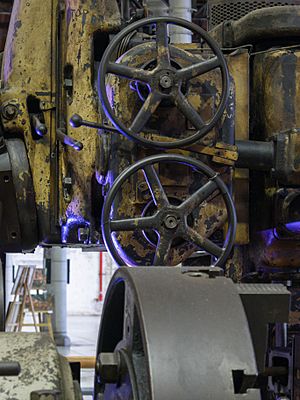Eveleigh Railway Workshops machinery facts for kids
Quick facts for kids Eveleigh Railway Workshops machinery |
|
|---|---|

Machinery in the blacksmiths shop at Eveleigh Railway Workshops
|
|
| Location | Main Suburban railway line, Redfern, City of Sydney, New South Wales, Australia |
| Owner | RailCorp |
| Official name: Eveleigh Railway Workshops machinery; Eveleigh Locomotive Workshops machinery | |
| Type | State heritage (movable / collection) |
| Designated | 2 April 1999 |
| Reference no. | 1141 |
| Type | Other - Transport - Rail |
| Category | Transport - Rail |
| Lua error in Module:Location_map at line 420: attempt to index field 'wikibase' (a nil value). | |
The Eveleigh Railway Workshops machinery is a special collection of old machines. These machines were once used to build and fix trains. They are located in Redfern, a suburb in Sydney, New South Wales, Australia.
This machinery is also known as the Eveleigh Locomotive Workshops machinery. It is owned by RailCorp, a government agency in New South Wales. The machinery is considered very important. It was added to the New South Wales State Heritage Register on April 2, 1999. This means it is protected because of its historical value.
Contents
The Story of Eveleigh Workshops
Redfern's Early Days
Long ago, the area now called Redfern had many sand hills and swamps. The Cadigal people, who were Aboriginal Australians, lived here. They found lots of food in this natural landscape.
The name Redfern comes from William Redfern. He received a large piece of land here in 1817. Before that, the area was known by other names like Roberts Farm.
Who Was William Redfern?
William Redfern (1774?-1833) had an interesting life. He was a surgeon's mate in the Royal Navy. He was involved in a naval protest in 1797. Because of this, he was sent to Australia as a convict in 1801.
He worked as an assistant surgeon on Norfolk Island. Later, he was pardoned and returned to Sydney. He became an assistant surgeon at the new Sydney Hospital in 1816. He also had his own private medical practice.
William Redfern was important for improving conditions on convict ships. He suggested that all ships should have a surgeon. This idea was put into practice. Even though some people looked down on him for being a former convict, he was friends with Governor Macquarie.
How Redfern Grew
In 1849, a new law changed Redfern. This law banned dirty businesses like slaughterhouses from the city. Many of these businesses moved to Redfern and Waterloo. They were attracted by the water supply.
By the late 1850s, Redfern was a busy suburb. About 6,500 people lived there. In 1859, Redfern became its own municipality. This meant it could govern itself. The Redfern Town Hall opened in 1870.
The Arrival of Railways
Sydney's first railway station was built in the Cleveland Paddocks. This area is now Prince Alfred Park. The station was named Redfern, honoring William Redfern.
In 1874, a new brick and stone station was built. At that time, the station we now call Redfern was known as Eveleigh. This name came from a beautiful old house nearby.
When Central Station was built, the name of Eveleigh Station changed to Redfern. However, the name Eveleigh was kept for the huge railway workshops. These workshops were located just beyond the station.
The Eveleigh Workshops' Importance
By 1886, the Eveleigh complex became one of the biggest employers in New South Wales. Redfern became a working-class suburb. Factories like Reschs brewery attracted many people.
Many migrants came to live and work in Redfern. By the 1880s, Syrian and Lebanese communities settled here. At the turn of the century, industry took over the area.
In the 1940s, a large part of Sydney's industrial activity was centered around Redfern Station. Today, Redfern is still a busy inner-city suburb. It has a high population, including many people from Lebanon and a large Aboriginal population.
What is the Machinery?
The Eveleigh Railway Workshops machinery includes many different types of machines. These machines were used in the workshops to build, repair, and maintain locomotives and other railway equipment. They show how trains were made and fixed in the past.
Why is it Heritage Listed?
The Eveleigh Railway Workshops machinery was added to the New South Wales State Heritage Register on April 2, 1999. This listing means the machinery is very important to the history of New South Wales. It helps us understand how railways developed and how people worked in the past.

